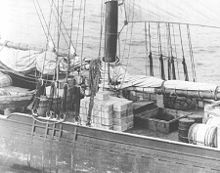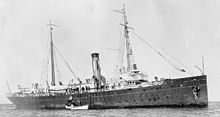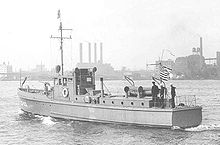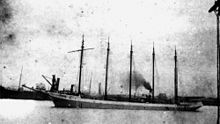Rum-running
Rum-running, or bootlegging, is the illegal business of smuggling alcoholic beverages where such transportation is forbidden by law. Smuggling usually takes place to circumvent taxation or prohibition laws within a particular jurisdiction. The term rum-running is more commonly applied to smuggling over water; bootlegging is applied to smuggling over land.
It is believed[
History
This section needs additional citations for verification. (June 2022) |

It was not long after the first taxes were implemented on alcoholic beverages that someone began to smuggle alcohol. The British government had "revenue cutters" in place to stop smugglers as early as the 16th century. Pirates often made extra money running rum to heavily taxed colonies. There were times when the sale of alcohol was limited for other reasons, such as laws against sales to American Indians in the Old West and Canada West or local prohibitions like the one on Prince Edward Island between 1901 and 1948.[5]
Industrial-scale smuggling flowed both ways across the
One of the most famous periods of rum-running began in the United States when Prohibition began on January 16, 1920, when the Eighteenth Amendment went into effect. This period lasted until the amendment was repealed with ratification of the Twenty-first Amendment on December 5, 1933.
At first, there was much action on the seas, but after several months, the Coast Guard began reporting decreased smuggling activity. This was the start of the Bimini–Bahamas rum trade and the introduction of
With the start of prohibition, Captain McCoy began bringing rum from Bimini and the rest of the
The rum-running business was very good, and McCoy soon bought a Gloucester knockabout schooner named Arethusa at auction and renamed her Tomoka. He installed a larger auxiliary, mounted a concealed machine gun on her deck, and refitted the fish pens below to accommodate as much contraband as she could hold. She became one of the most famous of the rum-runners, along with his two other ships hauling mostly Irish and Canadian whiskey as well as other fine liquors and wines to ports from Maine to Florida.
In the days of rum running, it was common for captains to add water to the bottles to stretch their profits or to re-label it as better goods. Often, cheap sparkling wine would become French champagne or Italian Spumante; unbranded liquor became top-of-the-line name brands. McCoy became famous for never adding water to his booze and selling only top brands. Although the phrase appears in print in 1882, this is one of several false etymologies for the origin of the term "The real McCoy".
On November 15, 1923, McCoy and Tomoka encountered the U.S. Coast Guard Cutter

The Rum Row
McCoy is credited with the idea of bringing large boats just to the edge of the 3-mile (4.8 km) limit of U.S. jurisdiction and selling his wares there to "contact boats", local fishermen, and small boat captains. The small, quick boats could more easily outrun Coast Guard ships and could dock in any small river or eddy and transfer their cargo to a waiting truck. They were also known to load float planes and flying boats. Soon others were following suit, and the three-mile limit became known as "Rum Line" with the ships waiting called "Rum row". The Rum Line was extended to a 12-mile (19 km) limit by an act of the United States Congress on April 21, 1924, which made it harder for the smaller and less seaworthy craft to make the trip.[6]
Rum Row was not the only front for the Coast Guard. Rum-runners often made the trip through
With that much competition, the suppliers often flew large banners advertising their wares and threw parties with prostitutes on board their ships to draw customers. Rum Row was completely lawless, and many crews armed themselves not against government ships but against the other rum-runners, who would sometimes sink a ship and hijack its cargo rather than make the run to Canada or the Caribbean for fresh supplies.[citation needed]
The ships



At the start, the rum-runner fleet consisted of a ragtag flotilla of fishing boats, such as the schooner
On the government's side, the rum chasers were an assortment of patrol boats, inshore patrol, and harbor cutters. Most of the patrol boats were of the "six-bit" variety: 75-foot craft with a top speed of about 12 knots. There was also an assortment of launches, harbor tugs, and miscellaneous small craft.
The rum-runners were often faster and more maneuverable than government ships, and a rum-running captain could make several hundred thousand dollars a year. In comparison, the
The Coast Guard relied on hard work, reconnaissance, and big guns to get their job done. It was not uncommon for rum-runners' ships to be sold at auction shortly after a trial – ships were often sold back to the original owners. Some ships were captured three or four times before they were finally sunk or retired[
Rum-running in Northern Europe in the 1920s and 1930s
Prohibitive alcohol laws in Finland (total ban of alcohol from 1919 to 1931), Norway (liquor above 20 per cent abv 1917–1927) and the Swedish
Alcohol smuggling today
For multiple reasons (including the avoidance of taxes and minimum purchase prices), alcohol smuggling is still a worldwide concern.
In the United States, the smuggling of alcohol did not end with the repeal of prohibition. In the Appalachian United States, for example, the demand for moonshine was at an all-time high in the 1920s, but an era of rampant bootlegging in dry areas continued into the 1970s.[10] Although the well-known bootleggers of the day may no longer be in business, bootlegging still exists, even if on a smaller scale. The state of Virginia has reported that it loses up to $20 million a year from illegal whiskey smuggling.[11]
The Government of the United Kingdom fails to collect an estimated £900 million in taxes due to alcohol smuggling activities.[12]
Absinthe was smuggled into the United States until it was legalized in 2007.[13] Cuban rum is also sometimes smuggled into the United States, circumventing the embargo in existence since 1960.[14]
See also
- Alcohol laws of the United States
- Alcohol in Colonial America
- American gangsters during the 1920s
- American Whiskey Trail
- Bootleggers and Baptists
- Bureau of Prohibition
- Bureau of Alcohol, Tobacco, Firearms and Explosives (ATF)
- Dry state
- Govenlock, Saskatchewan
- History of stock car racing
- Iron law of prohibition
- Izzy Einstein and Moe Smith
- Moonshine
- Nellie J. Banks
- Organized crime
- Prohibition
- Prohibition in Canada
- Prohibition in the United States
- Repeal of Prohibition
- Shebeen
- United States Customs Service
- Volstead Act
- Webb–Kenyon Act
References
- ^ "bootlegger". Oxford English Dictionary (Online ed.). Oxford University Press. (Subscription or participating institution membership required.)
- ^ Mary Murphy. "Bootlegging Mothers and Drinking Daughters: Gender and Prohibition in Butte Montana." American Quarterly, Vol 46, No 2, 1994.
- ^ Prohibition (miniseries), Episode 1, "A Nation of Drunkards". Directed by Ken Burns & Lynn Novick. Distributed by PBS.
- Portsmouth Herald(Oct. 1, 1917), p. 6, for "rum runner".
- ^ "Rum-running in P.E.I.'s Bygone Days". CBC News. September 30, 2018. Archived from the original on November 19, 2018. Retrieved October 19, 2021.
- ^ Kelley, Katie (October 1, 2014). "Episode 28 Rum Runner". A History of Central Florida Podcast. Retrieved January 30, 2016.
- ^ History Alive:Rumrunners, Moonshiners and Bootleggers Trivia and Quotes (television). History Channel. February 23, 2007. Archived from the original on June 29, 2011. Retrieved March 11, 2011.
- ^ "X-boats War On Smugglers" Popular Mechanics, August 1932
- ^ Mitter, Adrian (2019). "Rum Runners of the Baltic — The Rise of Transnational Liquor Smuggling Networks in Interwar Europe" (PDF). Zeitschrift für Ostmitteleuropa-Forschung / Journal of East Central European Studies. 68 (4): 527–550. Retrieved November 10, 2020.
- S2CID 142229259.
- ^ "Moonshine in Virginia creates loss of $20 million: Havocscope Black Markets".
- ^ "Alcohol smuggling in the United Kingdom: Havocscope Black Markets".
- ^ Asimov, Eric (May 13, 2009). "Absinthes to Go Mad Over". The New York Times. Retrieved 27 January 2012.
- ^ Swift, Aisling (2008-05-24). "Two charged with smuggling Cuban rum, cigars into Southwest Florida". Naples Daily News. Retrieved 2022-02-02.
Further reading
- Allen, Everett S. The Black Ships: Rumrunners of Prohibition. Little, Brown. 1979. ISBN 0-316-03258-1.
- Carse, Robert. Rum Row.
- Cohen, Daniel. Prohibition: America Makes Alcohol Illegal. Millbrook Press. 1995.
- Frew, David. Prohibition and Rum Running on Lake Erie (The Lake Erie Quadrangle Shipwreck Series, Book 4) Erie County Historical Society; 1ST edition (2006) ISBN 1-883658-48-9.
- Gervais, Marty. The Rumrunners: A Prohibition Scrapbook. Biblioasis. 1980, Revised & Expanded 2009. ISBN 978-1-897231-62-3.
- Hunt, C. W. Whisky and Ice: The Saga of Ben Kerr, Canada's Most Daring Rumrunner. Dundurn Press. 1995. ISBN 1-55002-249-0.
- Karson, Larry, "American Smuggling and British white-collar crime: A historical perspective" (PDF), Papers from the British Society of Criminology Conference 2012.
- Karson, Lawrence. American Smuggling as White Collar Crime. New York: Routledge, 2014.
- Mason, Philip P. Rumrunning and the Roaring Twenties: Prohibition on the Michigan-Ontario Waterway. Wayne State University Press, 1995.
- Miller, Don. I was a rum runner. Lescarbot Printing Ltd. 1979.
- Montague, Art. Canada's Rumrunners: Incredible Adventures and Exploits During Canada's Illicit Liquor Trade. Altitude Publishing Canada. 2004. ISBN 1-55153-947-0.
- Moray, Alastair. The diary of a rum-runner. P. Allan & Co. Ltd. 1929, Reprint in 2006. ISBN 0-9773725-6-1
- Snow, Nicholas. "Law of the Rum-Runners: Self-Enforcement Mechanisms Given Weak Focal Points". Grove City College. October 2007.
- Steinke, Gord. Mobsters & Rumrunners Of Canada: Crossing The Line. Folklore Publishing. 2003. ISBN 1-894864-11-5.
- Willoughby, Malcolm F. Rum War at Sea. Fredonia Books. 2001. ISBN 1-58963-105-6.
- Mark Thornton, The Economics of Prohibition, Salt Lake City, UT: University of Utah Press, 1991.
- Yandle, Bruce. Bootleggers and Baptists: The Education of a Regulatory Economist. Regulation 7, no. 3. 1983: 12.
External links
- Data on Alcohol Smuggling: Havocscope Black Markets
- http://www.uscg.mil/history/articles/RumWar.pdf
- http://www.uscg.mil/history/webcutters/Seneca1908.pdf
- http://www.providenceri.com/narragansettbay/rum_runners.html#blackduck
- "Bootleggers and Baptists in Retrospect"
- "Submarine on Wheel is Used as Rum Runner" Popular Mechanics, November 1930
- Rum Runner at A History of Central Florida Podcast
